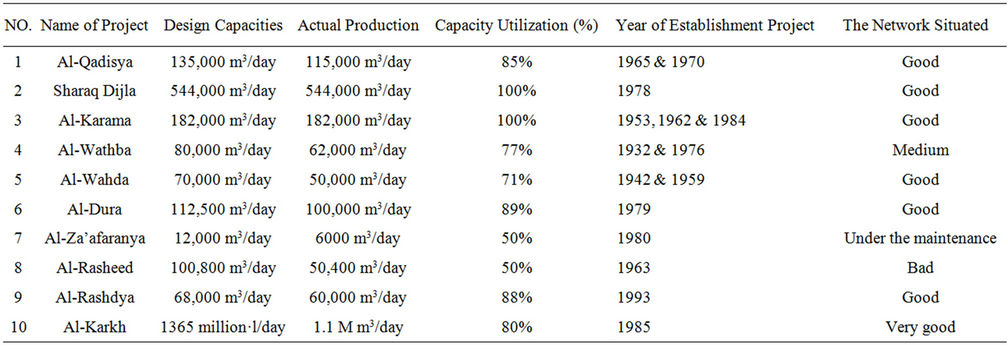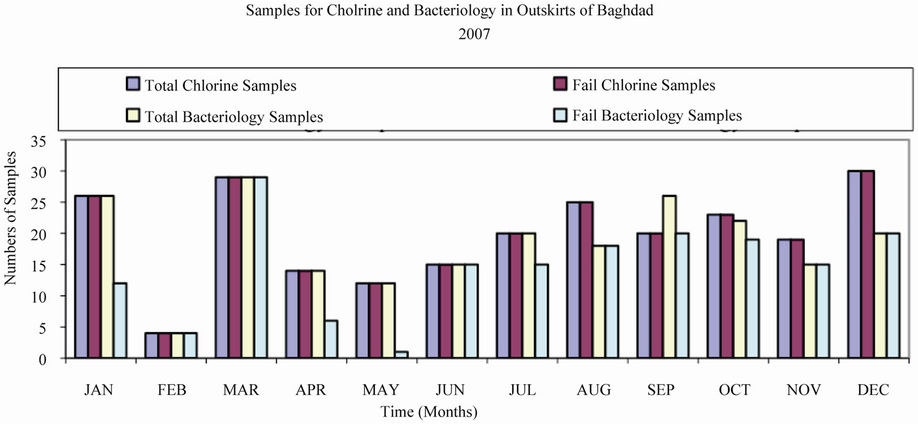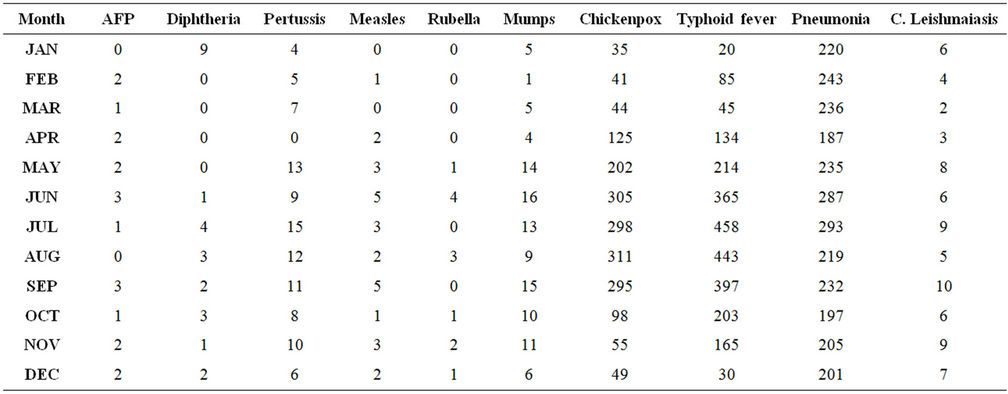Journal of Environmental Protection
Vol. 3 No. 6 (2012) , Article ID: 20073 , 5 pages DOI:10.4236/jep.2012.36064
Evaluation of Drinking Water Pollution and Health Effects in Baghdad, Iraq
![]()
Civil & Environmental Engineering Department, Delhi Technological University (DTU), Delhi, India.
Email: allaaaenab@gmail.com
Received January 26th, 2012; revised February 21st, 2012; accepted March 20th, 2012
Keywords: Drinking Water; Water Pollution; Water Supply; Drinking Water Network; Sewerage Network; WTP’s; Wastewater; Iraq Environment and Water-Borne Diseases
ABSTRACT
Contamination of water reserves by biological, chemical, and radiologic agents may affect the health of millions of residents in the Iraq as well as many others throughout the world. Fatal outbreaks of cholera struck several provinces of the country, including Baghdad. The United Nations Environment Programme (UNEP) also says air pollution, resulting from burning oil and aggravated by war, is cause for concern. The study area Baghdad has been divided into two parts: Central Baghdad and Outskirts of Baghdad (included in Baghdad but near the boundaries of Baghdad). The outskirts of Baghdad comprises of 4 cities: Al-Hussaniya located in northern part of Baghdad, Abu-Gurabe located in the western side of Baghdad, Jissr Diyala located in the eastern side of Baghdad and finally Al-Mahmodiya located in the southern side of Baghdad. These cities are in very poor situation in terms of water supply. The quality of water supplied is bad as no attention is given to WTP's in these places, which is also because of the fact that given the insecure war conditions, these areas are inaccessible. The sewage is thrown directly into the river because these areas do not have sewage treatment plants. In case of central Baghdad the water supply and sewerage network are broken in some places. Due to this there is mixing of water between the two networks. For this study we taking water supply samples and collect all the samples from WTPs and water supply network (houses, shops and different places). We made the analysis to parts first bacteriologies, second chlorine and after analysis these samples in lab we will give in our study numbers of fail samples, type of diseases and how many case during year 2007 in Baghdad City. Also in this study we will give Estimated Deaths from Water-Related Diseases 2010 to 2035.
1. Introduction
Country background. Iraq is rich in natural and human resources and was a middle-income country in the 1970s. But years of conflict, sanctions and wars have had a significantly negative effect on Iraq’s economy with people suffering a severe decline in their standards of living. Although in the 1970s the health and educational institutions in Iraq were regarded as among the best in the Middle East, the current health and education indicators of Iraq are well below the regional average. An estimated 10 percent of the population has income of less than a dollar a day, and unemployment is estimated at 25 - 30 percent of the population. According to the United Nations, approximately 25 percent of the population is dependent on food rations. The agriculture sector has declined and is characterized by poor productivity and inefficient water use. Infrastructure in all sectors, including water and sanitation, is dilapidated and mostly dysfunctional. The current political and security environment remains unstable with negative impacts on basic services. Rebuilding the Iraqi economy and institutions remain a formidable challenge [1].
Environmental issues Iraq are also facing very serious environmental problems, including poor water quality, air pollution, waste management, contaminated sites and the deterioration of key ecosystems. With environmental problems neglected to a large extent prior to the war as well, the decades of war, conflicts and economic sanctions have further worsened the environmental conditions. The problems are aggravated by the country’s weak environmental governance structure.
Before the Gulf War, Iraq’s water supply system employed what was at the time up-to-date technology and functioned efficiently. However, with the imposition of economic sanctions, Iraq was unable to expand or update the system, resulting in extensive leaks throughout the network, and a steady decline in the volume and quality of water supply. This, combined with the growth of urban populations, has affected everyday life, with some areas receiving almost no water. Waterborne infectious diseases, which had been eradicated prior to sanctions, also spread again due to the impossibility of importing chlorine disinfectants [2].
2. Objectives
• Current status of Iraq’s environment and gather information on assistance initiatives in the environmental field being implemented.
• Evaluation of drinking water quality.
• Increased incidence of diseases will be attributable to degradation of normal preventive medicine, waste disposal and water purification/distribution.
3. Study Area
Iraq’s quality of drinking water and water used for agriculture is poor, violating both Iraq National Standards and WHO guidelines. Leaking sewage pipes and septic tanks contaminate the drinking water network with wastewater [3].
• Only 17% of wastewater is treated before discharged into the environment [4].
• 80% of Iraqis do not treat their water before drinking [5].
Water-borne diseases are widespread due to polluted drinking water supplies. In the first six months of 2010, there were over 360,000 diarrhea cases as a result of polluted drinking water and a lack of hygiene awareness among local communities, particularly vulnerable groups such as women and children [6].
Iraqi Ministry of Environment in 2009 indicate that bacteriological contamination in the water supply varies between governorates, ranging from 2.5% up to 30%, with the current average of 16% greatly exceeding the Iraqi National Drinking Water Standards and WHO Guidelines for Drinking Water permissible limit of 5% [7].
• Every day at least 250,000 tonnes of raw sewage is pumped into the Tigris River threatening unprotected water sources and the entire water distribution system [8].
• Consumers directly and illegally puncture the main water supply lines with their individual and unhygienic leaky plastic hoses causing direct and continuous contamination [9].
During the hot summer months, the specter of widespread cholera outbreaks loomed over the country. Cholera is characterized by profuse diarrhea, which can lead to severe dehydration and death if left untreated. The World Health Organization (WHO) reported a total of 73 laboratory-confirmed cholera cases in Iraq from April 28 to June 4, 2010. 10 times more than WHO officials found during the same period last year [10].
4. Data Procurement
Samples were collected from central and outskirts of Baghdad for residual chlorine and bacteriology tests for the years 2007. The data of permissible quality of supplied water in ten cities, located in central Baghdad, also available. The health data containing the number of cases of various diseases for all the months of the year 2007 in Rusafa and Karakh districts this data showing us number and type of water born diseases in Baghdad.
5. Results
Table 1 present the design capacities, actual production and the capacity utilization in respect of different water treatment plants. It may be observed that other than 2 plants viz. Al Qarama and Sharaq Dijla, all other plants are operating at much lesser capacities, which need to be augmented for better performance.
Water samples were collected from central and outskirts of Baghdad and were made to undergo chlorine

Table 1. Capacity of WTP’s in centre Baghdad.
and bacteriology tests. The test results indicated that the water quality in the cities located in the outskirts of Baghdad is in a very erratic state. This is due to the insecure war conditions that make these areas inaccessible. Also the absence of wastewater treatment plants in these areas made the conditions worse as the waste is directly thrown in the river. The chlorine and bacteriology test results are shown in Figures 1 and 2 respectively.
Table 2 and Table 3 show that more number of water borne diseases cases was reported in Rusafa district as compared to the Karkh district. This is due to more pollution in water networks in the Rusafa area.
6. Estimate: Simple Proportional Projection
The simplest estimate of future deaths from water-related diseases comes from assuming that the proportion of deaths to total population experienced today will be maintained in the future. As total population grows, total water-related deaths will grow annually. This can be seen in Equation (1), which applies a simple proportional assessment of water-related deaths to official median estimates of future population growth to 2035.
Equation (1): Deaths from Water-Related Diseases 2010 to 2035:
Simple Proportional Assessment [11].

where TD1 = Total water-related deaths, 2010 to 2035.
 = Sum over the period 2010 to 2035.
= Sum over the period 2010 to 2035.

Figure 1. Samples for cholrine and bacteriology in centre of Baghdad 2007.

Figure 2. Samples for chlorine and bacteriology in outskirts of Baghdad 2007.

Table 2. Number of cases of mentioned diseases in Rusafa district in 2007.

Table 3. Number of cases of mentioned diseases in Karkh district in 2007.
(D/P)2010 = Water-related deaths in 2010/Population in 2010.
Pt = Population in a given year.
Given: D = 36000/year [12].
P2010 = 27,000,000 [13].
Growth Rate = 2.5% [13].
P2035 = 50,056,491.
7. Conclusions
The study area Baghdad has been divided into two parts: Central Baghdad and Outskirts of Baghdad (included in Baghdad but near the boundaries of Baghdad).
• The outskirts of Baghdad comprising of 4 cities: AlHussaniya, Abu-Gurabe, Jissr Diyala and Al-Mahmodiya were found in poor condition in terms of water supply and sewerage due to inaccessibility, lack of proper attention and insecure war conditions. In central Baghdad the water treatment plants are satisfying the standard conditions but the water supply network is in a poor condition.
• Efforts are needed from the concerned authorities for renovation of water treatment plants and network in inaccessible and war prone areas. The endeavors of the local people of Iraq are required in keeping their environment clean. Thus the people should be made aware about the dire consequences of negligence towards these issues.
• Around 100 infants die every day, many from waterborne diseases, with around 36,000 infants dying before they celebrate their first birthday.
• 1 child out of every 20 in Iraq dies before reaching their 5th birthday.
• At the present child mortality rate, around 1,300,000 Iraqi children will die, many from water-borne diseases, by 2035.
• Around 1,300,000 Iraqi children’s lives will be saved if Iraq succeeds in attaining the MDG target of reducing the current 41 deaths for every 1000 live births to 21 deaths for every 1000 live births by 2035. This will be much more likely to be achieved by improving the quality of drinking water as well as with the population adopting better hygiene practices.
REFERENCES
- World Bank, “Iraq Household Socio-Economic Survey,” IHSES-2007 Tabulation Report.
- Wikipedia Foundation Inc., “Text is Available under the Creative Commons Attribution-Share Alike License,” 2011.
- CCA, “Common Country Assessment IRAQ,” 2009. http://www.iauiraq.org/reports/CCA_Final.pdf
- Geopolicity, “Iraq Water and Sanitation Scoping Study,” 2010. http://www.geopolicity.com
- UNDAF, “An overview of the United Nations Development Assistance Framework Iraq,” 2010. http://www.iauiraq.org/reports/UNDAF%20Booklet-English-WEB.pdf
- WHO, “World Health Organization Position Papers,” 2010.
- UNAMI, “United Nations Assistance Mission for Iraq United Nations Country Team in Iraq Water Resource Management White Paper,” 2010.
- UNICEF, “Iraq Wastes 50% of Water,” 2011. http://www.google.com/hostednews/afp/article/ALeqM5ik87fAUtGSxTXLz5SszEVpX-CNIg?docId=CNG.261b2d3c66888006d3d84c66c4b96323.851
- UNICEF, “World Water Day 2011,” 2011. http://iq.one.un.org/documents/155/UNICEF%20media%20advisory%20and%20facts.pdf
- Free Drinking Water News, 2010. http://www.freedrinkingwater.com/water_quality/quality1/1-dirty-water-or-bombs-dangerous.htm
- P. H. Gleick, “Dirty Water: Estimated Deaths from WaterRelated Diseases 2000-2020,” Pacific Institute for Studies in Development, Environment, and Security, 2002. http://www.pacinst.org
- UNICEF, “Iraq’s Children 2007,” 2007. http://www.unicef.org/infobycountry/files/Iraqs_Children_2007.pdf
- World Bank, “A Human Rights Report on Trafficking in Persons, Especially Women and Children,” 2011.

